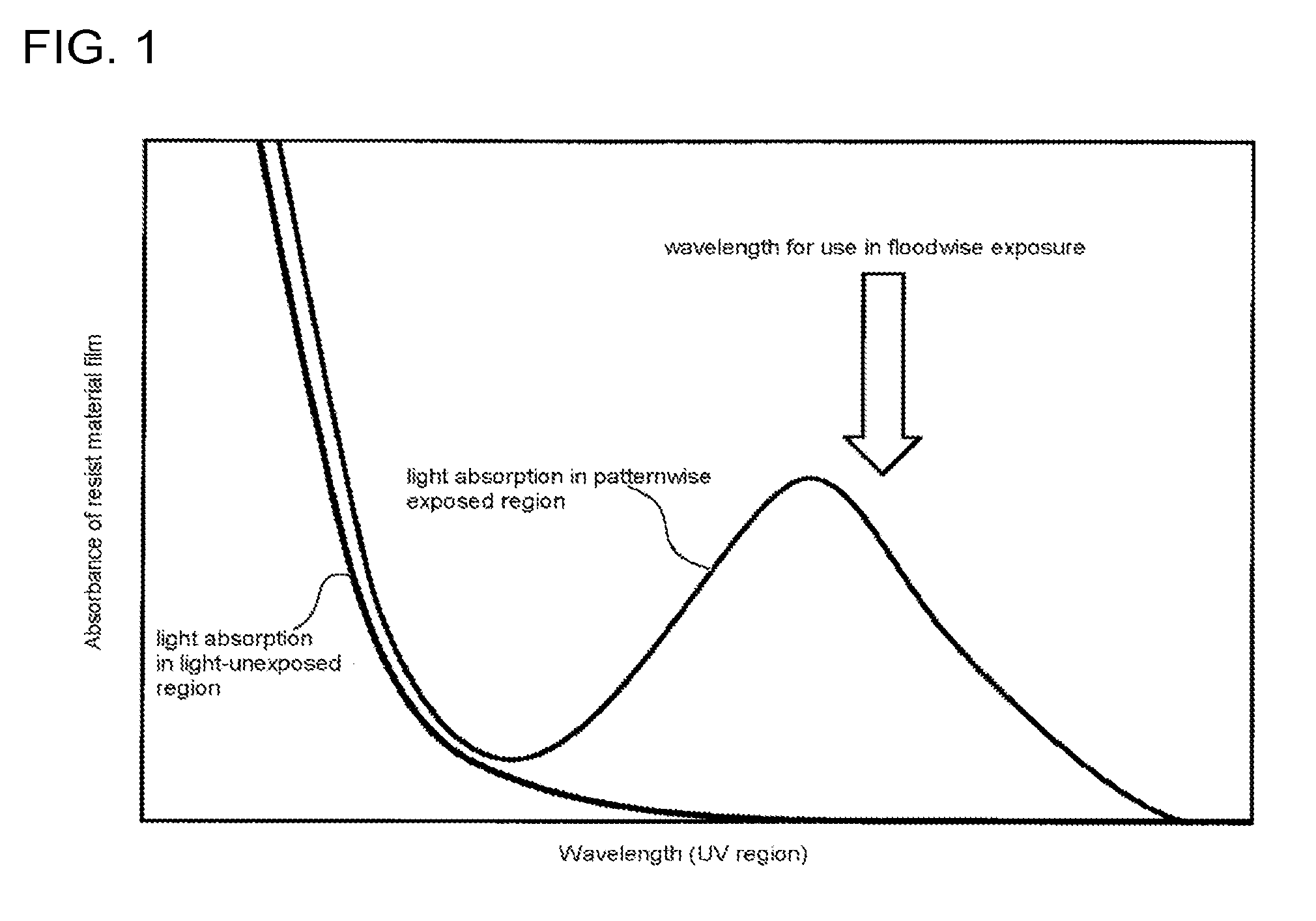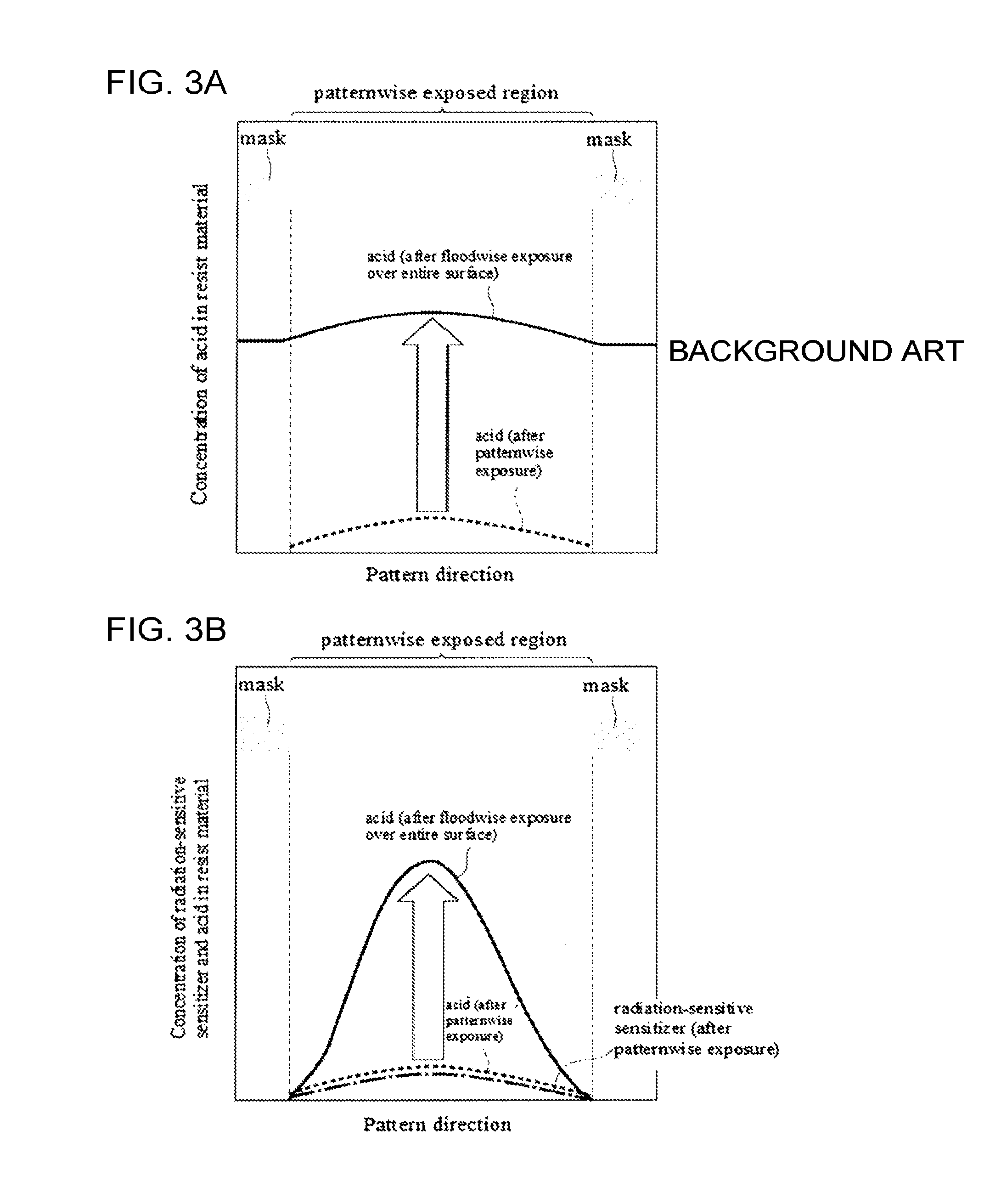Resist-pattern-forming method and chemically amplified resist material
a resist material and resist pattern technology, applied in the field of resist pattern forming method and chemically amplified resist material, can solve problems such as hiccups in the practical application of euv lithography
- Summary
- Abstract
- Description
- Claims
- Application Information
AI Technical Summary
Benefits of technology
Problems solved by technology
Method used
Image
Examples
synthesis example 1
[0353]55 g (50 mol %) of the compound (M-1), 45 g (50 mol %) of the compound (M-2) and 3 g of azobisisobutyronitrile (AIBN) were dissolved in 300 g of methyl ethyl ketone, followed by polymerizing for 6 hrs under a nitrogen atmosphere while maintaining a reaction temperature at 78° C. Following the polymerization, a reaction solution was added to 2,000 g of methanol dropwise to permit solidification of the polymer. Thereafter, the polymer was washed twice with 300 g of methanol and white powder thus obtained was filtered, followed by drying at 50° C. overnight under a reduced pressure, thereby obtaining a polymer (A-1) served as the base component (1). The polymer (A-1) has the Mw of 7,000 and the Mw / Mn of 2.10. In addition, the result of 13C-NMR analysis indicated that the proportions of the structural units derived from the compound (M-1) and the compound (M-2) were respectively 52 mol % and 48 mol %.
synthesis example 2
[0354]55 g (42 mol %) of the compound (M-3), 45 g (58 mol %) of the compound (M-1), 3 g of AIBN and 1 g of t-dodecyl mercaptan were dissolved in 150 g of propylene glycol monomethyl ether, followed by polymerizing for 16 hrs under a nitrogen atmosphere while maintaining a reaction temperature at 70° C. Following the polymerization, a reaction solution was added to 1,000 g of n-hexane dropwise to permit solidification and purification of a polymer. Subsequently, 150 g of propylene glycol monomethyl ether was added again to the polymer, then 150 g of methanol, 37 g of trimethylamine and 7 g of water were further added thereto, and a hydrolysis reaction was allowed to proceed for 8 hrs with refluxing at the boiling point to permit deacetylation of the structural unit derived from (M-3). After the reaction, the solvent and triethylamine were distilled off under reduced pressure, the resulting polymer was dissolved in 150 g of acetone, and then the solution thus obtained was added to 2,0...
example 1
[0366]The chemically amplified resist material (R-1) was spin-coated onto a silicon wafer in “CLEAN TRACK ACT-8” available from Tokyo Electron Limited, and subjected to PB at 100° C. for 60 sec to form a resist material film having an average thickness of 50 nm. Subsequently, the resist material film was irradiated with an electron beam using a simplified electron beam writer (“HL800D” available from Hitachi, Ltd., power: 50 KeV, current density: 5.0 ampere / cm2) to permit patterning. The patterning was a line and space pattern (1L 1S) obtained by using a mask configured with a line part having a line width of 150 nm and a spaces part formed by neighboring line parts with an interval of 150 nm. After the irradiation with the electron beam for patterning, the following operation (a) or (b) was performed.
Operation (a): Without Floodwise Exposure
[0367]After the irradiation with the electron beam, PEB was carried out at 110° C. for 60 sec in the CLEAN TRACK ACT-8. Then, a development was...
PUM
| Property | Measurement | Unit |
|---|---|---|
| Volume | aaaaa | aaaaa |
| Nanoscale particle size | aaaaa | aaaaa |
| Nanoscale particle size | aaaaa | aaaaa |
Abstract
Description
Claims
Application Information
 Login to View More
Login to View More - R&D
- Intellectual Property
- Life Sciences
- Materials
- Tech Scout
- Unparalleled Data Quality
- Higher Quality Content
- 60% Fewer Hallucinations
Browse by: Latest US Patents, China's latest patents, Technical Efficacy Thesaurus, Application Domain, Technology Topic, Popular Technical Reports.
© 2025 PatSnap. All rights reserved.Legal|Privacy policy|Modern Slavery Act Transparency Statement|Sitemap|About US| Contact US: help@patsnap.com



